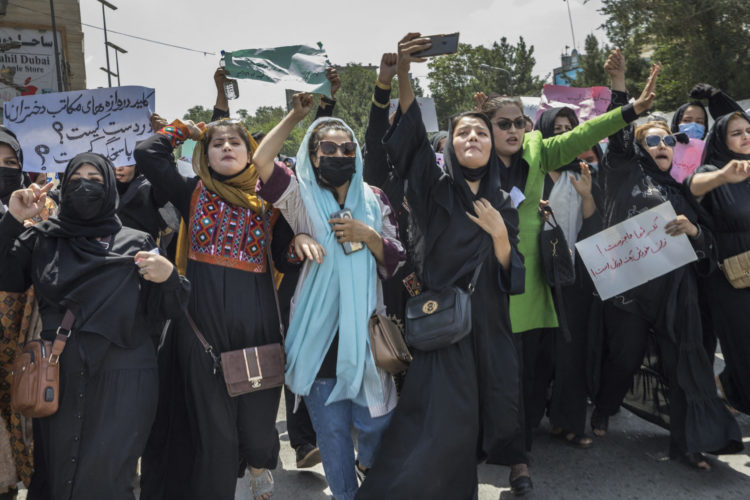There has been a small but steady wave of recent stories focused on the plight of women in Afghanistan, who have been stripped of their rights — to jobs, to education, to choosing their wardrobe or having their hair uncovered in public, to having a voice in their lives in public and, often, at home — since U.S. troops left the country and the Taliban reclaimed power last year. The point was made without equivocation in the third paragraph of a story by Bushra Seddique, an Afghan refugee who is an editorial assistant at The Atlantic:
Afghanistan is, once again, the worst place in the world to be a woman.
Seddique was born in 1999; she was a toddler when the U.S. invaded Afghanistan following the 9/11 attacks. For all the cost and controversy of America’s 20-year war, Seddique said the overthrow of the Taliban in was “the beginning of a luckier time” for girls like her. That contrasted with the lives of their mothers and grandmothers, who spent most of their lives in the “unblessed years.”
Seddique’s next sentence:
Now that the time of unblessing has returned, it has become clear that as we grew up, my generation was witnessing not the beginning of a new future, but an anomalous moment in our country’s sad history.
When I clicked on the Atlantic story, I expected to do a quick scan and move on. But as the story went on, my reading slowed and paid closer attention. Then I went back for a reread. It’s not long — just 29 paragraphs, some fat, some a single line. The approach is direct and transparent, starting with the headline: WHAT AFGHANS WANT THE REST OF THE WORLD TO KNOW. The story spine is built on interviews Seddique did with relatives, friends, former teachers and colleagues back home. The structure is unadorned — two-graf anecdote, the one-sentence story theme, a few grafs of personal introduction, then brief scenes from the interviews — was graced with lines or short clauses that made my breath catch:
Related reading
Bushra Seddique on her escape from the Afghanistan’s Taliban
Anand Gopal in the New Yorker with stories from behind the burqa
A brief tribute to a young man killed trying to escape Afghanistan
A 14-year-old girl who loved school now watches through the window as her younger brother boards the school bus each morning. “Are the Taliban at war with women?” she asks Seddique through tears. A 22-year-old woman teaches a secret school in her basement to as many as 80 teenage girls and wishes she had room for more; the 14-year-old dreams of finding a secret school even it if means getting caught and beaten by the Taliban. Illiterate women joined university professors at a recent protest in Kabul in which women demanded BREAD, WORK, FREEDOM. Seddique’s sister loved colorful clothes, lipstick and eyeliner; all those now languish in her bedroom because women who venture outside the home must wear head-to-toe black “like the whole nation is in mourning.” The return to “zero” for Afghan women, who are “so very tired.”
While Seddique uses the first person for credibility and transparency, she turns this story over to others. Her sadness is apparent but never self-absorbed. It is instructive to read her piece about how she and her youngest sister escaped in the chaos of the U.S. troop pullout a year ago. That story is a pure first-person narrative — the family vote about who would stay and who would go, days of tension on a bus with other escapees, wading through a sewage-infected pond, ambivalence about the U.S., ambivalence about the best ways to fight for her family and country, the growing realization that she had no real choice:
I was a journalist and a woman stuck in a country now ruled by terrorists who hated journalists and women.
In that story, Seddique makes five quick mentions of the dangerous decisions she made to keep her laptop even as the Taliban, and then the Americans, required escaping refugees to jettison everything else. After months in holding camps, she and her sister move in with relatives already in the U.S. and she gets a fellowship with The Atlantic, doing work “the Taliban would never let women and girls do.” She ends her personal journey tale a line that should haunt and inspire all journalists:
I smuggled my laptop past the Taliban and carried it across continents to a free country so I could write this story, so I could tell you this.
That story was published just a month ago. Now Seddique returns by remote to Afghanistan to face what she left behind. She takes us on the ground in women’s lives and dares us to see what she feels. At the close, Seddique gives two grafs over to possible policy solutions involving economic and politics sanctions and human-rights efforts. It is a careful consideration, as clear and unpretentious as the rest of the piece. She makes no mention of a return to war but suggests more funding for secret schools, with a plea that is more a sign than a scream:
In secret, behind closed doors, Afghanistan is still breathing.
I would have suggested stopping the story there. Seddique adds one more paragraph, two short, parallel sentences contrasting the despair of a woman still in Afghanistan with her own dim glimmer of hope. But I might be wrong. And as an editor, I believe the tie goes to the writer.



